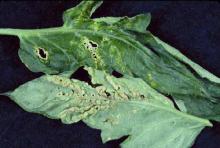Cause Physiological. Oedema (edema) is more prominent when ambient temperatures are lower than soil temperatures and soil moisture and relative humidity are high. Low transpiration rates along with a rise in water absorption increase cell pressure, erupting epidermal cells so that inner cells enlarge and protrude. That causes the inner cells to die and discolor (yellow, brown, or rust), giving the impression that a parasitic organism is involved.
Symptoms Symptoms appear primarily on lower leaf surfaces. The disorder shows up first as small, clear, watery blisters (0.06 inch in diameter), which can be very numerous. As blisters dry, they turn opaque and usually reddish brown. Oedema is unsightly but not a serious threat to the health of affected plants.
Cultural control
- Regulate watering so that soil does not remain saturated.
- Fans to circulate air and increase transpiration may help to reduce oedema.
Reference Horst, R.K. 1990. Westcott's Plant Disease Handbook, 5th ed. Reinhold, NY: Van Nostrand.


